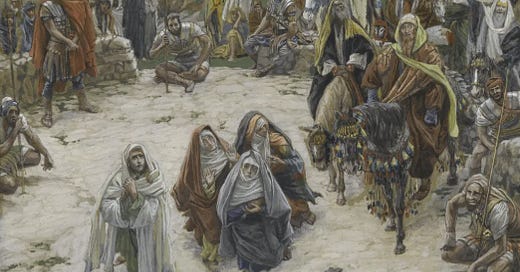Holy Week, Day 5: “Surely This Was…”
“When the centurion, who stood there in front of Jesus, saw how He died, he said, ‘Surely this man was the Son of God!’” —Mark 15:39
He was familiar with death. Too familiar.
The Roman centurion wasn’t new to violence.
He likely commanded men who mocked, beat, and nailed prisoners to crosses.
He was part of the machine of power and fear.
And yet—something happened.
He stood in front of Jesus.
He watched Him suffer.
And in the moment of death—something broke open inside him.
“Surely this man was the Son of God.”
This is one of the most stunning lines in the crucifixion narrative.
Because it doesn’t come from Peter.
Not from a disciple.
Not from a religious leader.
It comes from a soldier.
From a man complicit in the suffering.
And yet, even here, the Spirit is at work.
Seeing Jesus Clearly, At Last
In Tissot’s “What Our Lord Saw from the Cross,” we see Roman soldiers in the crowd, casual, watchful.
Pictured with his red cloak, this centurion stands out among them.
(“What Our Lord Saw from the Cross” by James Tissot. Brooklyn Museum)
He’s not distraught like John.
He’s not gazing up from the foot of the cross like Mary.
But he is watching.
And as Jesus dies—not with rage, but with forgiveness, surrender, and divine love—the centurion sees something he’s never seen before.
He sees a King, not of force, but of peace.
A strength that yields.
A love that doesn’t resist violence, but absorbs it and transforms it.
He sees the truth.
And he says it out loud.
This is how transformation begins.
Identity and Transformation: Even for the Oppressor
Neuroscience tells us that true identity transformation rarely begins with new information—it begins with embodied experience. Being near someone who acts differently than expected can disrupt our internal assumptions and awaken new awareness.
The centurion didn’t repent because of a sermon.
He repented because he saw a different kind of death—and it revealed a different kind of King.
Even those shaped by systems of violence and control are not beyond reach.
Even those who have harmed others—knowingly or unknowingly—are not immune to the Spirit’s invitation to change.
That is the scandal of grace:
It reaches the enemy.
It transforms the oppressor.
It calls even the complicit to come closer.
The Invitation: Where Have I Been Blind?
On this Good Friday, the Cross asks us: Where have I been blind to Jesus?
In my comfort or complicity?
In my participation in broken systems?
In my assumptions about who God could use—or save?
And perhaps even more: Where is Jesus showing up now—quietly, clearly—and am I ready to see Him?
The centurion’s transformation begins not with shame, but with honest recognition.
He says what he sees.
And something shifts.
That can happen for us, too.
Reflect: From Complicit to Convicted
What have I been blind to in myself, in others, or in God?
Where might I have unknowingly contributed to hurt or stayed silent when compassion was needed?
Are there places where I’ve missed opportunities to reflect Jesus’ compassion or to stand with those who are hurting?
Where has fear, self-protection, or indifference kept me from seeing or responding to others with Christlike love?
Where is the Spirit gently opening my eyes today?
What truth am I finally ready to name?
“Surely this man was the Son of God.” —Mark 15:39
“Open my eyes, that I may see…” —Psalm 119:18
“Search me, O God, and know my heart…” —Psalm 139:23
“Create in me a clean heart, O God…” —Psalm 51:10
“Even now, declares the Lord, return to Me with all your heart.” —Joel 2:12
Good Friday Practice: A Prayer of Confession and Clarity
Find a quiet space. Light a candle if possible.
Sit in stillness, and imagine yourself standing beside the centurion.
Feel the earth tremble.
See the sky darken.
Watch the moment of death—and hear the centurion whisper,
“Surely this man was the Son of God.”
Now, pray:
Jesus, Son of God, You see all things.
You know where I’ve missed Your presence.
You know the places I’ve chosen comfort over compassion.
But today, I stop. I look. I listen.
Open my eyes. Create in me a clean heart.
Let the truth of who You are rewrite the story of who I am.
Amen.
Then, if you’d like, write one sentence that names what you now see more clearly about Jesus, yourself, or your world.
End with a moment of silence.
A Closing Prayer
Jesus,
You were seen that day—not by the ones we’d expect,
But by the man who helped crucify You.
And yet You didn’t turn away or call down the forces of heaven.
You stayed. You loved. You forgave.
I confess where I’ve been blind—
To You, to others, to my own complicity.
But today, I want to see.
Let me look again.
Let me see clearly.
Let me name the truth.
And let that truth transform me.
Amen.
To view the other articles in this Holy Week series focusing on the paintings of Tissot, please click below:
Day 1: The Cup and the Crushing
https://debbieowen.substack.com/p/holy-week-day-1-the-cup-and-the-crushing?r=1m6dv
Day 2: The Disciples Who Fled—Running from the Pain
https://debbieowen.substack.com/p/holy-week-day-2-the-disciples-who?r=1m6dv
Day 3: Blind Guides and the Undefended Heart of Christ
https://debbieowen.substack.com/p/holy-week-day-3-blind-guides-and?r=1m6dv
Day 4: Love that Stays
https://debbieowen.substack.com/p/holy-week-day-4-love-that-stays?r=1m6dv
A Maundy Thursday Reflection: Presence in the Pain
https://debbieowen.substack.com/p/a-maundy-thursday-reflection-presence?r=1m6dv
Day 5: “Surely This Was…”
https://debbieowen.substack.com/p/holy-week-day-5-surely-this-was?r=1m6dv
Day 6: coming soon
Day 7: Easter morning, coming soon




